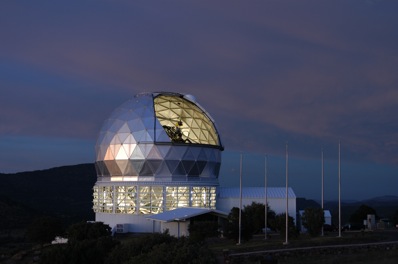A new planet found orbiting a red giant star at a distance of just 0.6 AU may shed new light on how aging stars influence nearby planets before they are consumed.
The new exoplanet is around six times the mass of Jupiter and orbits its dying star – HD 102272 – at a distance closer than Venus is to our Sun. The discovery was made by a team of astronomers from Penn State and Nicolaus Copernicus University in Poland using the Hobby-Eberly Telescope of McDonald Observatory in southwestern Texas. By using the telescope’s spectrograph, the astronomers observed patterns in the spectral lines of the light radiating from HD 102272 that represent the fingerprint of a star that is moving alternately toward and away from Earth as it wobbles in space in response to the gravitational pull of an orbiting planet. The specific pattern of these shifts allowed the scientists to determine that at least one planet, and possibly even two, orbit the star. If the second planet exists, the system would become the first multi-planet system discovered around a red giant star.
“If real, the second planet has a very eccentric (e=0.68) orbit with a semi-major axis of 1.6 AU,” team member Professor Alexander Wolszczan tells Astronomy Now. Wolszczan is also the discoverer of the very first planets found outside our Solar System over 15 years ago.

The Hobby-Eberly telescope is located at the McDonald Observatory in far West Texas, which has the darkest skies of any major observatory in the continental United States. Image: Marty Harris/McDonald Obs./UT-Austin.
The team hope that the intriguing system will shed light on the ways in which aging stars can influence nearby planets, although it is already well known that stars of about 0.5-8 solar masses swell and expand towards the end of their lifetimes, possibly swallowing up nearby planets. A similar fate is destined for the Earth in a few billion years time.
“The star is twice as massive as the Sun, meaning that it's been evolving much faster,” says Wolszczan. “Possibly, it will engulf the planet in less than ~100 million years, when it rapidly expands after helium ignition”. From the perilously close distance of 0.6 AU the steadily expanding giant would appear in the planets' alien skies as a huge, reddish disc that is more than 16 times larger than the face of Earth's full Moon appears to us.
“Just like with our planets, the one out there is not much younger than the star, which may currently be at, say, no more than 1.5 billion years,” says Wolszczan. “Detecting planets like that tells us about long-term survival of planetary systems around evolving stars and chances of life to cope with the process or, maybe, even start over, since habitable zones move away and expand as a red giant evolves in time.” Indeed, when our own Sun swells into a red giant, there is the possibility that Jupiter’s icy satellite Europa may fall into the sought after habitable zone. Currently shrouded by an icy shell but possibly hiding an ocean beneath, if it were to exist closer to the Sun, it might become a warm ocean world that could possibly support life.
Wolszczan and colleagues hope that the discovery will teach them about the evolution of planets orbiting extremely close to a red giant star, and what causes planets to avoid forming too close to such a monster. “Although the planet we discovered conceivably could be closer to the star without being harmed by it, there appears to be a zone of avoidance around such stars,” explains Wolszczan. “Our discovery pushes it back to about 0.6 AU, which is the size of the new planet's orbit. It is important to find out why planets don't want to get any closer to stars, so one of our next steps is to try to figure out why this zone of avoidance exists and whether it occurs around all red giant stars.”
HD 102272 is located 1,200 light-years from the Earth in the constellation Leofrom: http://astronomynow.com/081120Planetfoundorbitingdangerouslyclosetoredgiant.html





 RSS Feed (xml)
RSS Feed (xml)